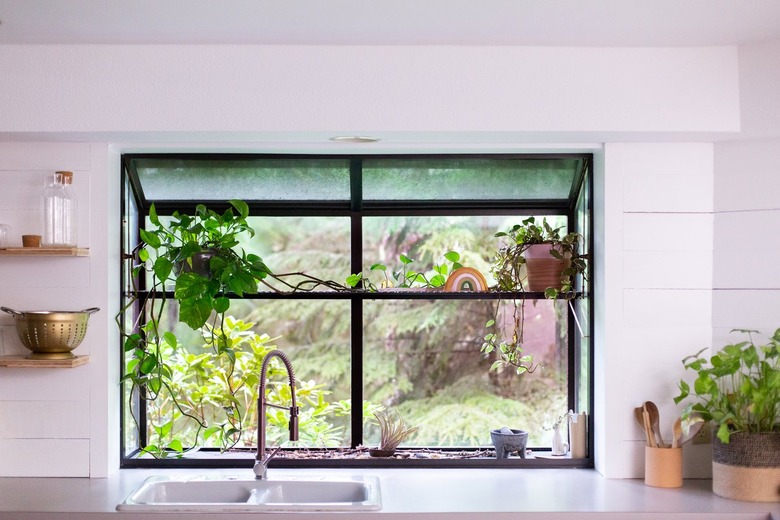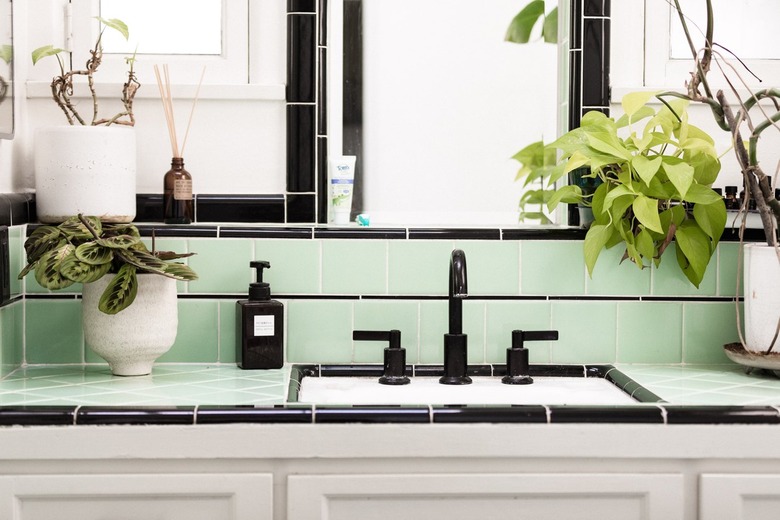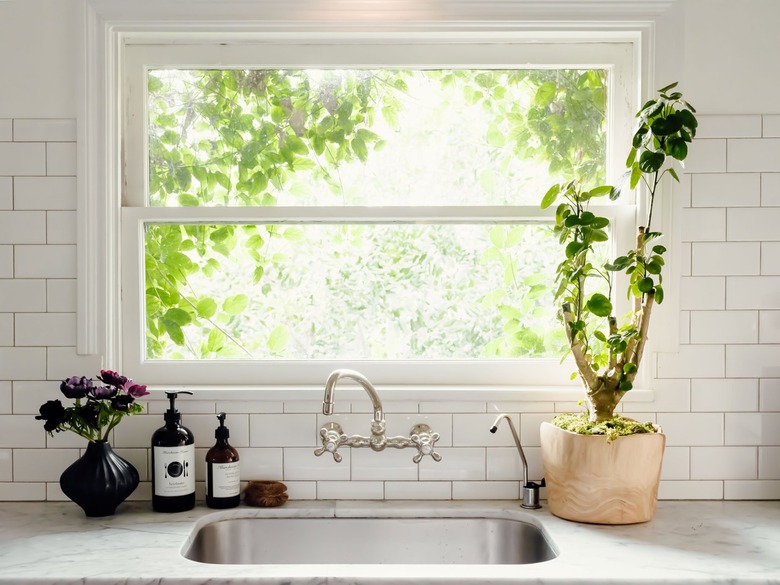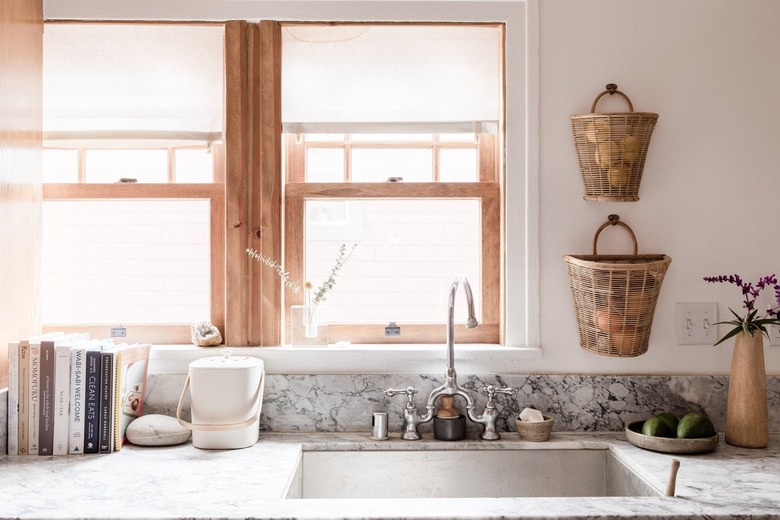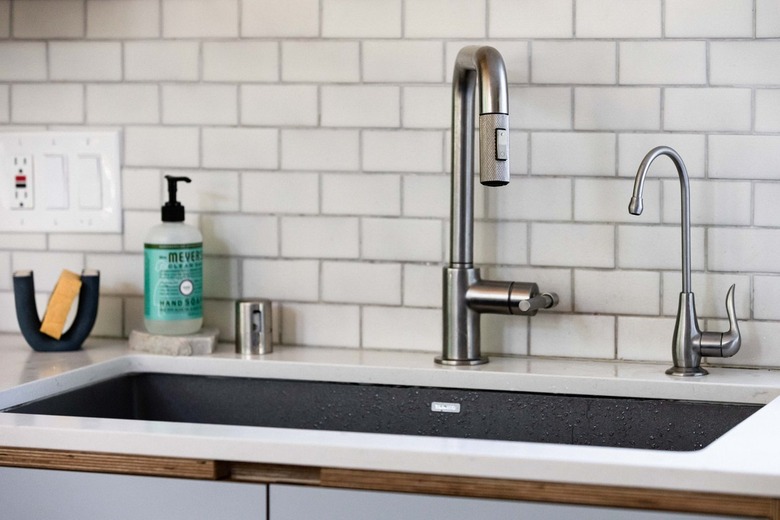What Is A Drop-In Sink? Pros And Cons Explained
We may receive a commission on purchases made from links.
As homeowners tackling a kitchen remodel, you may find yourself contemplating various types of sinks. But before you start thinking about all the different materials and styles — and single-bowl versus double bowl options — you need to think about the installation. More specifically, do you want a drop-in sink or undermount sink?
What is a Drop-in Sink?
What is a Drop-in Sink?
A drop-in sink is a basin that drops into a precut hole in the countertop. Also known as a top-mount, over-mount, or self-rimming sink, this popular design has a rim that sits on top of the counter and supports the weight of the sink. It can be used on any bathroom vanity, kitchen counter, or bar that is structurally able to support its weight, which can be considerable if it's made of a heavy material such as porcelain or cast iron. Drop-in sinks used to be the only option available, and it's still more common than its more stylish counterparts — the undermount, farmhouse, and integrated sink — for two reasons: It's usually the least expensive option, and it will work with any type of countertop.
Both drop-in sinks and undermount sinks are available in a variety of materials, including:
- Stainless steel: Commonly found in kitchens
and on bars, but occasionally you'll see them in the bathroom. - Enameled or porcelain-coated cast iron: Known
for its durability and being easier to clean than other sink materials,
enameled cast iron comes in white as well as a variety of other colors. - Composite: Composite sinks are fashioned with acrylic
resins blended with bits of real stone, such as quartz or granite, making them extremely durable. They are usually black or gray, but one innovative
product combines jute with concrete to produce a smooth, white material similar
to porcelain. - Solid-surface material: This material is made
from a blend of different acrylic or polyester resins, and it can be formulated
in a variety of colors and styles, often intended to look like natural stone.
Solid surface sinks tend to be white, although many other colors are possible. The
color is uniform throughout the body of the sink and won't chip off. Solid
surface sinks are often integrated with countertops, but stand-alone drop-in
sinks are also available. - Fireclay: Traditionally used to manufacture
farmhouse sinks, fireclay is an extremely durable, smooth, and somewhat heavy
material akin to porcelain. - Copper: Copper is as lightweight as stainless
steel, and although it's more commonly used for farmhouse and undermount sinks,
it's a great choice for a drop-in for your designer kitchen, bar, or bathroom. - Stone: If you aren't on a tight budget, you can
purchase a real drop-in sink for upscale bathrooms made of solid granite,
quartz, or marble.
Some of these materials are heavy, but that usually isn't a problem, because the rim provides plenty of support, even when the sink is full of water. When circumstances call for a lighter material, the best choices are stainless steel and copper.
Although most drop-in sinks are square or rectangular, shape isn't a limiting factor. It's easy to find an oval or round option for bathrooms and kitchen with more than one sink.
Pros and Cons of a Drop-In Sink
Pros and Cons of a Drop-In Sink
If you're shopping for a kitchen sink, you're almost sure to consider a drop-in option — so it's a good idea to keep the following advantages in mind:
- Availability: The drop-in sink is
ubiquitous. Every retailer is guaranteed to offer
several options, and you'll always find a choice of colors, sizes, and
materials. - Adaptability: Drop-in sinks work with any type
of countertop material, including laminate. Undermounts and some farmhouse
sinks only work with solid materials, such as stone, composite, solid surface
material, or solid wood. - Cost: Drop-ins are the least expensive sinks on
the market, costing as much as 50% less than a comparable undermount. - Installation: Drop-in sinks are easy to install,
requiring no support other than the countertop on which they rest.
Although there isn't much to dislike about drop-in sinks, there is one definite problem, and that's the rim. It forms a border around the sink opening that prevents you from wiping debris from the countertop directly into the sink. The rim also collects debris, and if it isn't properly sealed, it allows water to seep between the sink and countertop and into the sink cabinet. It can detract from the appearance of the countertop while reducing the available working space.
Pros
- Wide availability
- Work with any type of countertop material
- Relatively inexpensive
- Easy to install
Cons
- Rim can collect debris and water
- Conventional (not custom) look
- Takes up some counter space
Drop-In Sink Installation and Maintenance
Drop-In Sink Installation and Maintenance
Installation of any sink is going to involve a bit of plumbing, including installing the drain and the faucet. Needless to say, if plumbing isn't your thing, you're going to need a pro. When it comes to dropping in the sink, the toughest part of the job is cutting the hole for it. Most sinks come with a cutting template to make this job easier, but cutting through some materials, such as stone, composite material, or laminates is a job best left to someone with the right tools and the skill to use them properly.
Just before you drop the sink into place, manufacturers recommend laying a bead of silicone caulk around the circumference of the hole. This helps prevent water from seeping under the rim. You'll also want to caulk the outer edge of the rim after installation is complete and you've tightened all the clamps to keep dirt and water from getting underneath. The sink has to be level, or water will pool in the bottom and won't go down the drain. Check the level of the countertop and make any necessary corrections before installing the sink. Once you've done this, all you have to do to level the sink is to make sure the rim sits flush against the countertop on all sides. If there's a wider gap on one side than the other, this usually means that the hole is too small and needs to be widened slightly. If you buy a counter with a precut hole, you have to use a sink that will fit that exact shape and size.
The amount of energy required to clean and maintain a drop-in sink is minimal. Most materials need little more than an occasional wipe-down with warm water, some dish soap or baking soda, and occasionally a little vinegar for disinfecting. But with copper, avoid using baking soda, vinegar, lemon juice, or anything similarly acidic or caustic, otherwise, you'll ruin the patina. And because the rim forms an edge on the countertop, dirt and water tend to collect there, and if you let water stand, it eventually softens and degrades the caulk, allowing mold to form and water to seep under the rim. It's easy to prevent this. Just wipe down around the edge of the sink with a sponge or rag when you're cleaning the counter, preferably every day. While you're at it, wipe around the base of the faucet. Sometimes water collects there and seeps through into the cabinet below.
What is an Undermount Sink?
What is an Undermount Sink?
An undermount sink is the opposite of a drop-in sink. Instead of having the ability to be literally dropped into a hole in the countertop, an undermount kitchen sink is installed below the counter, resulting in no lip between the sink and the countertop. Instead, the edge of the sink will be level with your countertop. If you're looking for a sleeker, more streamlined look in your cook space, an undermount sink might be what you're looking for.
Pros and Cons of an Undermount Sink
Pros and Cons of an Undermount Sink
Like any kitchen sink, an undermount sink has pros and cons to ponder as well.
- Appearance: An undermount sink will look sleek
and smooth — something to prioritize if your overall kitchen design is linear and
modern. - Easy Cleaning: With no lip around the edges, cleaning
will be fairly easy. You can seamlessly wipe food scraps into the sink. - Extra Space: Also, with the absence of a lip
comes a bit more counter space.
Then there are the cons. Undermount sinks take up valuable storage space in the cabinet below. Since they require a custom-sized hole and an intricate installation process, these sinks can be difficult to replace. They can only accompany certain countertop materials since they're so heavy and need lots of support, which means you'll need a countertop in granite, quartz, or marble. And they tend to be more expensive than their drop-in counterparts because the installation is much more involved.
Pros
- Looks sleek and stylish
- Easy to clean
- Allows for extra counter space
Cons
- Take up under-sink storage space
- Difficult to replace
- Only work with granite, quartz, or marble countertops
- Expensive
Undermount Sink Installation and Maintenance
Undermount Sink Installation and Maintenance
The installation of an undermount sink is a lot more complex than installing a drop-in sink. Most homeowners can handle the ease of installing a drop-in sink; installing an undermount sink, on the other hand, requires a trained professional (also known as a fabricator).
At the beginning of the process, the fabricator will come to your home to measure your existing kitchen countertop. Or, if it's a new build, you can provide the dimensions. After that, you'll pick out your undermount sink, faucet, and countertop slab. The fabricator will cut the slab according to the dimensions, while also cutting a hole for the undermount sink and holes for the faucet. After buffing the top and holes, the undermount sink will be installed upside-down and caulked in place with clear silicone. After the clear silicone dries and the sink is firmly in place, the countertop with your new undermount sink can be installed in your kitchen.
Since there is no caulked lip surrounding an undermount sink, you'll need to be mindful of water that can seep in between the sink and the counter. This can unfortunately cause mold to grow, but you can avoid this by ensuring that the sink has been properly sealed on all sides. It can also help to go with a non-porous countertop material for your kitchen, such as quartz or granite. Crumbs can also accumulate in that space, so keep a close eye on it and clean it or even recaulk if necessary.
Undermount vs. Drop-In Sink
Undermount vs. Drop-In Sink
If you're still torn between a drop-in and undermount sink for your kitchen, here are a few key points to remember as you make your final decision:
- Drop-in sinks are easy to install but don't look
as clean as undermount sinks. - You'll need a bigger budget to accommodate an
undermount sink, since it's more difficult to install and requires a more
expensive countertop material, like marble or quartz. - A drop-in sink doesn't take up as much space
underneath as an undermount sink, something you should think about if storage
is a top priority. - An undermount sink will allow you to wipe food
scraps directly into the sink, but it can be challenging to see all those
crumbs and water spills that might be pooling in the space between the sink and
countertop.
